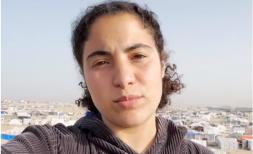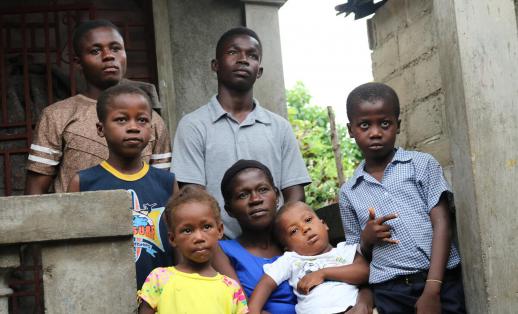Every Last Child - the world's invisible children

Delphine received a losing ticket in the lottery of birth. She lives with her father and two brothers in a single-room makeshift mud and thatch hut on the fringes of Mbuji Mayi, a sprawling Congolese mining town. Each day, she walks past the school whose fees her father cannot afford, looking for informal jobs that can help to feed her and her family.
She was lucky to get this far – three siblings failed to make it past their first birthday, the last of them dying alongside her mother during childbirth. The house where they live is on unclaimed, poorly drained land next to a stagnant pool that makes an effective breeding ground for mosquitoes. Her father cultivates a tiny plot of land, which grows a few scrappy-looking vegetables, equipped only with a hand hoe. For Delphine, her brothers and father, getting to the end of each day is a minor victory, as they battle against the odds to survive hunger and the constant threat of sickness.
It’s the situation of children like Delphine, repeated every day countless times around the world, which has driven Save the Children to launch its new global campaign, Every Last Child, with the goal of removing the barriers that prevent millions of children from surviving and learning.

Most children today are healthier, wealthier and better educated than at any point in history, a trend that has only accelerated in the last generation. But the averages hide the fact that millions of children have been bypassed by recent gains. 16,000 children still die every day from causes that in rich countries are either forgotten or easily tackled - like pneumonia, diarrhoea, and birth complications. 60 million children are out of school, and an estimated 250 million of those in school aren’t even learning the basics.
Increasingly, these children are falling behind because of who they are, and where they live – in other words, a toxic combination of poverty, discrimination and geography is preventing millions of children from being lifted by a rising social and economic tide.
The situation of 8 million refugee children is a case in point. They are five times more likely to be out of school than other children in the countries to which they’ve been displaced. Sometimes, there are practical challenges in providing services to recently arrived refugees. But most refugee populations have been stuck in one place for many years, and more often it’s a combination of under-investment and discriminatory policies that are thwarting these children’s futures.
A similar story can be told for girls. Despite a shrinking gender gap in school enrolment, in all but two African countries, girls are still less likely than boys to complete primary education. Late enrolment in school means that by the time many of these girls reach the later grades of primary school, they are in their teens. At this point, learning is often cut short by the need to support a meagre family income through paid labour, household tasks or child marriage. In other cases, the threat of sexual violence in and on the way to school, or more prosaic problems like the absence of toilets for menstruating girls, can lead them to drop out early.
And two decades after apartheid ended, ethnicity is still a deciding factor in the future of millions of children. In Peru, indigenous Quechua children are one and a half times more likely to die before their fifth birthday than children from a Spanish-speaking background. In Vietnam child mortality rates among ethnic minority children are three and a half times higher than for their wealthier Kinh peers. A mix of poverty, geographical remoteness, language barriers, and discriminatory attitudes all play a part in this story. Our campaign research shows that in most countries where the data exists, the gap in life chances between the poorest regions and ethnic groups, and national averages has actually widened in the last decade.
If we want to sustain progress towards the 2030 development goals adopted at the United Nations last September, we’re going to need very different approaches from the ones that got us to where we are today. The international development community has now picked most of the low-hanging fruit, in terms of interventions that can achieve a big impact for a large number of children in the absence of more structural change in how societies and economies are organised.

As these stories of child refugees, girls, and ethnic minority children show, unless we tackle the underlying reasons why millions of children are falling behind, we are setting ourselves up to fail on the new global goals. This would be a major credibility failure on the part of the governments and UN agencies that spearheaded the goals. But more importantly, it would represent an unconscionable waste of human potential, storing up long-term problems that increasingly transcend national borders.
As the Syria migrant crisis demonstrates, refugees who cannot see a future for themselves in camps will resort to dangerous journeys to seek a better life elsewhere. Curtailing girls’ education is one of the best ways of transmitting poverty to the next generation – girls without a secondary education face much greater risks in pregnancy and childbirth, and have more children, who are more likely to be malnourished and poorly educated. Failure to address widening economic and social gaps between ethnic groups is a sure way of fuelling conflict and violence, and weakening the bonds between states and citizens on which good governance and prosperity depend.
So what can be done?
Through our campaign, we’re calling for three guarantees, which we believe can start to tackle the poverty, discrimination and a lack of political voice which undermine progress for children. Through a guarantee of fair finance, governments can create global rules and national systems that raise and spend money in ways that get every child the essential services they need to survive and thrive. A guarantee of equal treatment will entail changes in laws and policies that discriminate against children on the basis of gender, ethnicity, nationality or disability. It will also need to challenge and change the attitudes and behaviours that reflect and sustain those laws and policies. And a guarantee of accountability to children can start to give excluded children and their communities a voice in the decisions that affect them, starting with a transparent monitoring of progress towards the 2030 goals.
These are guarantees that need to be universal, for every last child. But the true test of their success will be whether they achieve real change in the lives of those children who’ve been forgotten, silenced, and pushed to the fringes of their societies. Rising to this challenge and delivering this agenda is an investment not just in their futures, but in our collective future.








